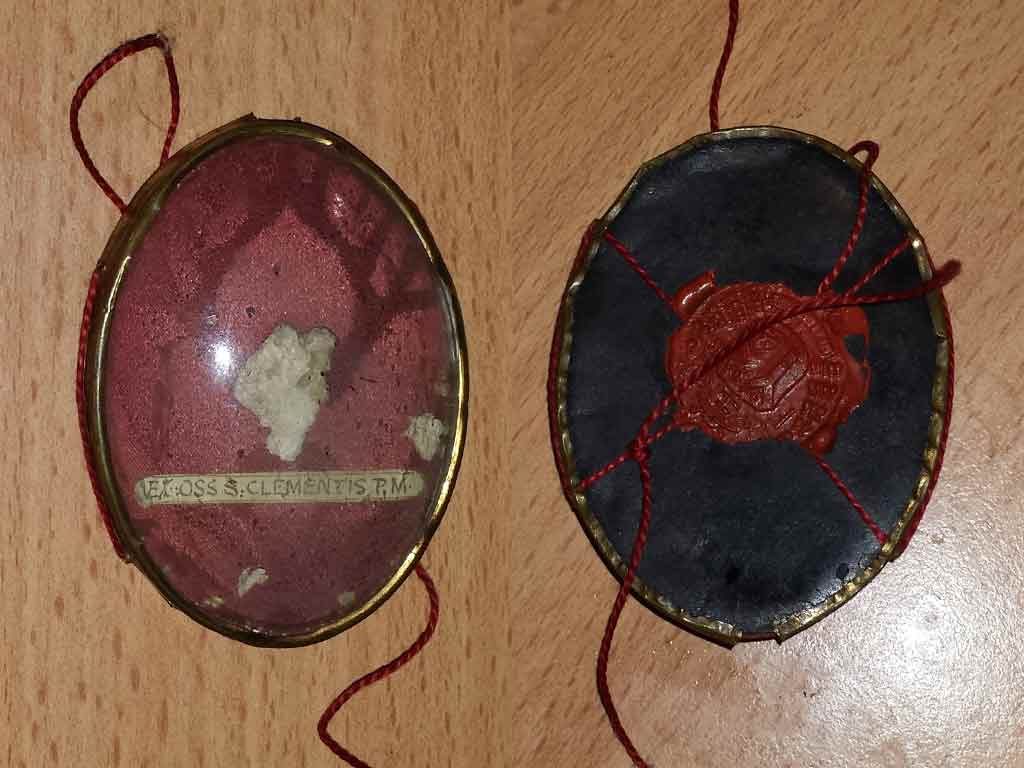Found in the Garbage: A Supposed Bone of a First-Century Pope
Behold this holy trash.

When people toss away trinkets like doll heads or little skeletons, it makes for some interesting conversations among garbage collectors, but about a year ago a rubbish service company in London found trash of holier proportions. And they’re still not quite sure what to do with it.
Enviro Waste found a red-wax-sealed box bound with equally red cords while picking out recycled materials from waste collections, The Guardian reported. Within this box was an oval with a mysterious sponge-like bone in it, and a weathered beige slip of paper with the Latin words “Ex Oss. S. Clementis PM.” Roughly translated into English, the label reads, “From the bone of the Saint Clement.”
Before Saint Clement was canonized, he succeeded St. Peter as Pope Clement I from 88 to 97 or from 92 to 101. It’s unclear because there are scant details of his life, but the few tales people shared over the years certainly seem to have elevated him beyond pontiff status. Allegedly, and for reasons unknown, the Roman emperor Trajan exiled him to Greece for a life sentence of hard labor.
Despite the hard conditions, Saint Clement continued to preach the gospel, and through his teachings, converted many of his prisoners to Christianity, which did not please emperor Trajan one bit. Trajan ordered him to be tied to an anchor and vaulted into the Crimean Sea. For this martyrdom and other virtuous acts, Clement became a highly regarded figure.
Over the years Enviro Waste has come across a nude painting of Albert Einstein, a stuffed cat dressed in a baby’s onesie, and sealed five pound note with Prince Charles’ signature, but a real Pope bone took the company’s owner, James Rubin by surprise.
“You can imagine our amazement when we realized our clearance teams had found bone belonging to a pope—it’s not something you expect to see, even in our line of work,” Rubin told The Guardian.
The Smithsonian Magazine has raised significant doubt as to the bone’s authenticity. Though legend posits Saint Clement’s remains were found and later kept in Rome’s Basilica di San Clemente, it’s highly unlikely the bone is a direct piece of Saint Clement.
Holding onto relics of saints has been an important part of religious identity and culture for some Catholics, particularly in the Middle Ages. It was thought heavenly exposure to such relics could heal wounds, cure diseases, or grant them a safe passage, for example. Often the relic’s power was only regarded as effective in one locality, so people from one town would steal another town’s relic to harness its power. Sometimes, people created fraudulent relics of Jesus and other saints.
Whether the bone is a fake or not, it’s still a significant find for Enviro Waste. So much so, that they are not sure what to do with it. They’ve asked the public to nominate a few appropriate locations for the bone to live out its dead days. If you feel so inclined, you can submit your case on their blog.










Follow us on Twitter to get the latest on the world's hidden wonders.
Like us on Facebook to get the latest on the world's hidden wonders.
Follow us on Twitter Like us on Facebook